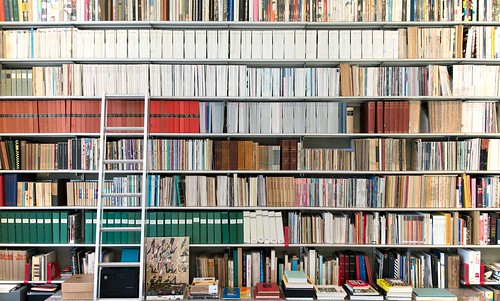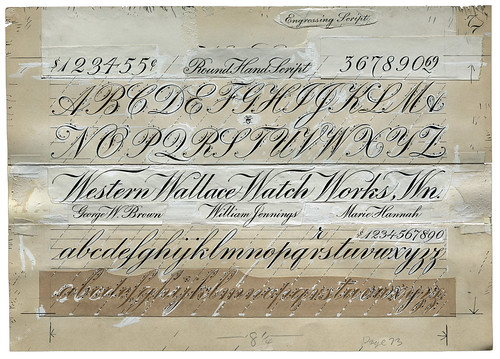Thursday, 9:00am
25 July 2019
Access all areas
Letterform Archive needs our help to move to a new home in San Francisco. Claire Mason describes her first encounter with the collection

Three years ago, in the summer of 2016, I took a sabbatical from Penguin Books in London and spent three months in the United States, writes Claire Mason.
Through social media, I had discovered Letterform Archive – an incredible museum and special collections library in San Francisco. Letterform Archive posted all kinds of visual communication, and avoided ring-fencing typography from graphic design. The Archive’s online persona was unusual, and excitable – slightly unbuttoned compared to the usual ‘stiff face’ of a library.
Caslon Specimen, 1844. The catalogue is a significant record of nineteenth-century type design, including classifications new to printers of that time, such as gothics (sans serif) and Italians (reversed contrast). (See also ‘New bottle old wine’ in Eye 98.)
Top. Examples of material typically shown to Letterform Archive visitors: artists’ books; psychedelic posters; type specimens; a cuneiform tablet; medieval manuscripts; and a leaf of the Gutenberg Bible.

I spent two weeks exploring the Archive. Earlier that year, Zuzana Licko (See Eye 43) and Rudy VanderLans had donated their archive of artefacts from their magazine Emigre (1984-2005) and their type foundry, Emigre Fonts, which is still active. One of the narratives of typographic history lies in the impact of technology. The work of Licko and Vanderlans on Emigre was one of these moments, and the Archive’s collection of drafts, test prints, specimens, correspondence and magazine paste-ups help provide access to the work of these two pioneers, their philosophy and their euphoric grasp of the emergent technology of the desktop computer.
Letterform Archive’s founder and guiding spirit is collector Rob Saunders, who informs this vast assembly of graphic ephemera, artefacts, prints, books, periodicals and type specimens with his boundless enthusiasm. As the motives of a collector can be both random and encyclopaedic, a visit to the Archive means you will almost certainly encounter something other than what you went for.
Letterform Archive holds Emigre Inc.’s complete archive, including material in various media, catalogues, development files and specimens for Emigre typefaces, alongside audio interviews and mechanicals for Emigre magazine.

I witnessed librarians Amelia Grounds and Kate Long outrun any Google search. I discovered US Modernist journals such as The Little Review; the German poster periodical Das Plakat; and the speedball lettering of Ross F. George. I used my hands and eyes to assess the weight and scale of books designed by Jan Tschichold and I stumbled upon the distilled mathematical elegance of Aaron Marcus’s 1970s typographic experimentations. Such fortuitous discoveries can only happen when you visit in person. Some archives can be overzealous and protective; by contrast Letterform Archive wants to share and celebrate the history of both typography and graphic design. If you get the opportunity to go, you must!
Claire Mason, designer and writer, London
Countless showcard writers and lettering artists got their start with Speedball pens and the easy-to-follow Speedball Text Book. Letterform Archive holds original artwork from Ross F. George (1889-1959), inventor of the pens and author of the first seventeen editions of the Text Book.
Letterform Archive hosts classes, researchers, corporate teams, and individual designers seeking inspiration. Guests are encouraged to look closely at the material (such as these Wolfgang Weingart posters) for a hands-on learning experience.

A note from the Eye editors
If opportunities such as those described by Claire Mason above are to continue, the Archive needs our help. A few months into 2019, the Archive was given notice by its landlord. Four years after opening its doors, the Archive has to move. Now, having located a new, larger home on the top floor of San Francisco’s American Industrial Center, it needs financial support to make it a reality. Dreams of a new gallery space, additional classes and the opportunity to expand the archive’s holdings all rest upon the success of its fundraising campaign, live on the Letterform Archive website. With the offer of several tiers of membership and rewards in exchange, you can now help Letterform Archive fund its new home.
The periodical wall in the reading room. The Archive holds thousands of graphic design and typography journals (including Eye magazine), design annuals and trade magazines from the nineteenth and twentieth centuries.

Eye is the world’s most beautiful and collectable graphic design journal, published for professional designers, students and anyone interested in critical, informed writing about graphic design and visual culture. It is available from all good design bookshops and online at the Eye shop, where you can buy subscriptions and single issues. You can see what Eye 98 looks like at Eye Before You Buy on Vimeo.

